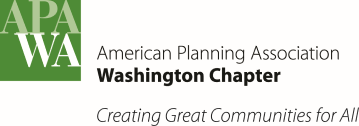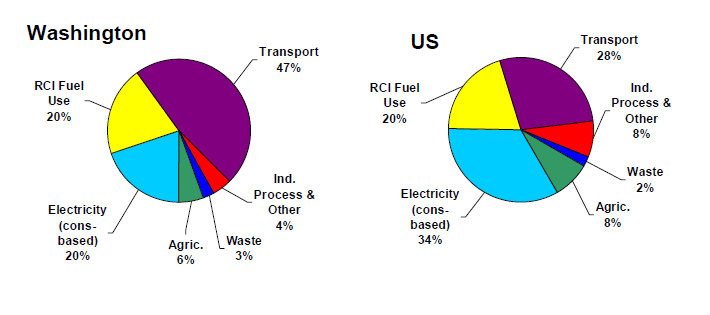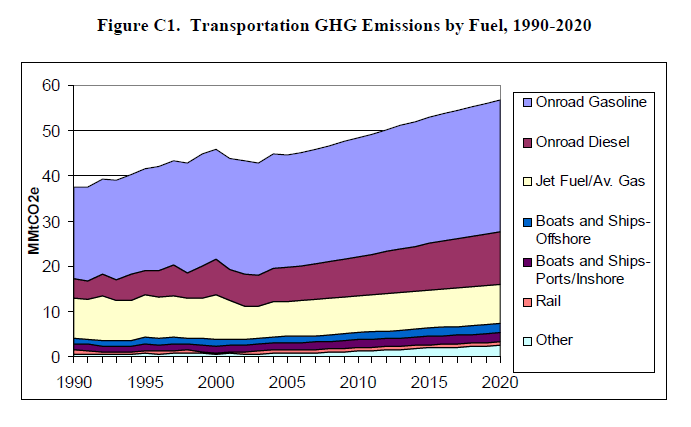- About Us
- Events & Training
- Professional Development
- Sponsorship
- Get Involved
- Resources
Sustainable Washington3.6 MobilityAccording to the Washington State Greenhouse Gas Inventory (2007), the transportation sector is the largest source of greenhouse gas (GHG) emissions in Washington, contributing 47% of the total. The following graphic (from page 8 of the report) compares the gross GHG emissions contributions by sector in Washington State vs. the U.S., as estimated for 2005. As noted in the report:While transportation makes up a larger fraction of Washington’s emissions – again, because of the state’s abundant hydroelectricity – on a per capita basis, Washington consumes about the same amount of gasoline as the US average. …As the result of Washington’s population and economic expansion and an increase in total vehicle miles traveled during the 1990s, on-road gasoline use grew by 23% between 1990 and 2005. Meanwhile, on-road diesel use increased by 98% during this period, suggesting an even more rapid growth in freight movement within the State. Aviation fuel use declined from 1990-2005[1]. The following graph, from the same report, illustrates the upward trend in GHG emissions. As a result, the total number of miles that we drive each year (known as vehicle-miles traveled or VMT) continues to increase, and VMT has grown 50% faster than population over the past decade.[3] Because of this increase in VMT, total GHG emissions are expected to exceed any reductions related to new auto efficiency standards and renewable fuel requirements. [4] Addressing the climate change / transportation connection will require a broad initiative that deals with mobility, land use, energy and fuels. The magnitude of the climate change problem has provided a new focus on these inter-relationships, reinforcing the idea that potential initiatives in one area must be integrated into an overall approach. As an example, flexible work schedules or telecommuting if implemented by themselves could be counter-productive if people simply used the resulting free time to take other trips. However, if these measures are implemented in conjunction with changes in land use and economic activity patterns coupled with pricing incentives to reduce VMT, then they begin to take shape as potential components of a coordinated response to climate change. Whatcom County, WA Traditional transportation-based approaches focus on reducing GHG emissions through methods such as: 1) improving transit systems and programs; 2) increasing participation in ridesharing, bicycling and walking; and 3) enhancing fuel efficiency of private vehicles and taxis and decreasing CO2 intensity of fuels. This approach can provide significant benefits; for example, the Governor’s Climate Action Team estimated that these improvements to the transportation system alone could reduce transportation GHG emissions by 30%.[5] However, it is clear that this type of approach is insufficient to address the magnitude of the problem and the root causes of climate change. For example, scientists agree that much deeper cuts in GHG emissions will be necessary by mid-century if we are to avoid the worst impacts of climate change. A successful approach will require a broad effort to significantly reduce VMT, provide more efficient modes of travel (i.e., transit), provide alternatives that do not require the use of fuel-consuming vehicles (biking, walking), and provide fuel alternatives other than traditional carbon-based sources (electricity, hydrogen, etc. – see the Energy section for further discussion of this topic). In order for this approach to be successful, transportation will have to be viewed differently – not as a way to move people based on their current needs and demands, but as an integral part of the climate change solution, addressing the inter-relationship between economic activity, land use and mobility, and health and equity. Traditional transportation solutions have sought efficient ways to move people and goods from point A to point B; new solutions will have to be found that combine with new patterns of land use and economic activity to reduce overall VMT and GHG emissions. With this in mind, local governments and community-based initiatives are critical for reducing Washington’s greenhouse gas emissions. Local governments have broad influence and, in some cases, exclusive authority over direct and indirect greenhouse gas emissions through their transportation and land use planning, development permitting processes, local ordinances, public education, and municipal operations. ActionsThe following list of actions is separated into three categories: Getting Started, Making a Commitment, and Expanding the Commitment. This graduated approach allows jurisdictions to implement measures that are appropriate to their community’s current level of involvement in climate change and sustainability issues and in consideration of locally adopted plans, codes, regulations, policies and goals. Getting Started3.6.1 Establish VMT reduction goals.Inventory and assess local VMT and trip patterns and their contribution to GHG emissions. Establish VMT reduction goals and integrate these with land use planning by focusing growth in urban centers and village nodes that include basic services within walking distance. (Local, Regional, and State Action) 3.6.2 Plan and fund a “complete streets” approach to transportation.Elevate the priority of transit, pedestrian, and bicycle improvements so that they comprise a proportionate share of local, regional, and state transportation dollars. Incorporate these modes consistently into the planning and development of new transportation projects. (Local, Regional, and State Action) 3.6.3 Support alternative travel modes in land use planning.Promote compact, transit-oriented, pedestrian-friendly, and mixed-use development as part of new and redevelopment proposals. New development should provide: pedestrian connections between retail, living, and working places; transit connections and facilities; traffic calming and other safety-related tools; sidewalks and trails; and pedestrian and bicycle amenities, as applicable. (Local Action) 3.6.4 Improve the bicycle and pedestrian environment.Require the planning and development of local and regional non-motorized, multi-use paths and on-road bicycle facilities through State policies and programs that prioritize and fund these types of transportation improvements. (Local , Regional, and State Action) 3.6.5 Increase public transit services and connections.Support increased public transportation, including continuing and strengthening State support for local and regional transit agencies and multi-modal transportation systems. Work to expand and provide inter-connected ties between existing transit services. Examples are seamless transfers and improved and coordinated pricing and ticketing. (Local, Regional, and State Action) 3.6.6 Support Commute Trip Reduction (CTR) programs.Use incentives to encourage the use of alternative modes of transportation. Support the development and expansion of commute trip reduction (CTR) incentive programs to encourage modes of transport other than single-occupancy vehicles. (Local Action) Whatcom County’s “Smart Trip” program is described in Project Example #1. 3.6.7 Educate citizens on alternative transport.Establish local programs to educate citizens on alternatives to automobile use, encourage carpooling and use of transit, and promote walking and bicycling use. Identify health and social benefits of alternative modes. State “seed money” could help create such programs throughout the state, which would help achieve goals related to greenhouse gas emissions, trip reduction, congestion relief, air quality, and public health. (Local and State Action) Anacortes, WA Making a Commitment3.6.8 Require GHG reduction goals in local regional and State plans and environmental reviews.Establish GHG emission reduction goals to be adopted as part of local, regional, and state transportation plans. Ensure consistency between regional goals and local goals in the local comprehensive plan certification processes and in the environmental analysis of transportation projects. (Local, Regional, State Action) See project example #2 for the Washington and Oregon DOTs award-winning NEPA work on the Columbia River Crossing Project. 3.6.9 Incorporate “green road” measures.Adopt a “green road” measurement system that evaluates project design and construction, including the use of pervious concrete, recycled, local materials, low impact development practices, LED lighting, multimodal accommodations, electric plug-in stations, etc. (Local, Regional, and State Action) 3.6.10 Promote non-transportation solutions.Local, regional, and state governments can partner with the business community by encouraging and supporting innovative programs like alternative work schedules, flexible before and after school child care programs to accommodate commuting parents, web-based conferences and trainings, and web-based shopping and service delivery programs. (Local, Regional, State and Private Sector Action) Expanding the Commitment3.6.11 Establish local multi-modal concurrency standards.Upgrade transportation concurrency standards under GMA and level-of-service standards for roadways to include transit, biking and walking. For communities not fully planning under the Growth Management Act or planning for critical areas only, develop a concurrency-type tool to enable such jurisdictions to ensure adequate public facilities and services. (Local, Regional and State Action) 3.6.12 Tie State funding to multi-modal concurrency and GHG reduction goals.Develop concurrency and level-of-service standards for alternative modes of transport. Coordinate state grants for transportation and other projects by developing selection criteria that prioritize multi-modal development and green house gas emissions reduction. (State Action) Bellevue and Kent WA 3.6.13 Remove hidden subsidies encouraging inefficient transportation and land use patterns.Examine and rework established tax and budget structures, looking for hidden subsidies and mistaken priorities which perpetuate reliance on single-occupancy vehicles, pavement, and lane miles. Consider such tools as parking restrictions or pricing mechanisms, re-prioritizing funding away from motor vehicle projects and pavement maintenance to enhance and expand non-vehicular systems such as walkways and bikeways. (Local Action) 3.6.14 Develop buy-local initiatives.Promote local purchasing for businesses and residents to support local vendors, services, and stores and to reduce GHG emissions from commerce-related transportation and food production and distribution. These initiatives can also stimulate the local economy. (Local and State Action) 3.6.15 Examine budget strategies.Consider creative approaches to infrastructure such as non-linear funding, which moves away from annual formulaic funding to emphasize significant opportunities to “change the system.” For example, periodically fund a significant local mobility initiative instead of allocating funding to maintenance at the same level every year. (Local Action)
1 Washington State Greenhouse Gas Inventory and Reference Case Projections, 1990-2020, Washington State Department of Ecology / Department of Community, Trade & Economic Development, Publication 07-02-021; December 2007. 2 National Personal Transportation Survey – Washington Data. 3 2007-2026 Washington’s Transportation Plan, November 14, 2006. 4 2008 Climate Action Team Report. |



